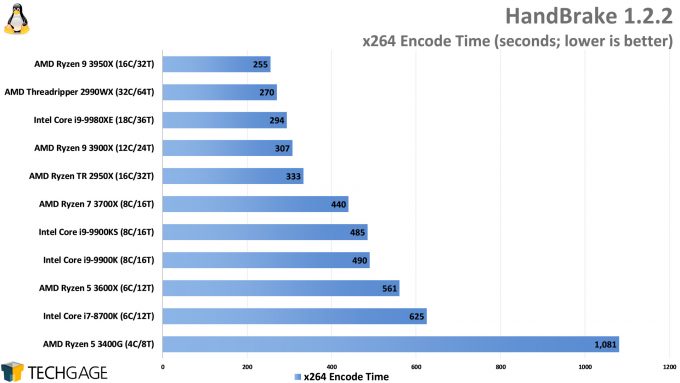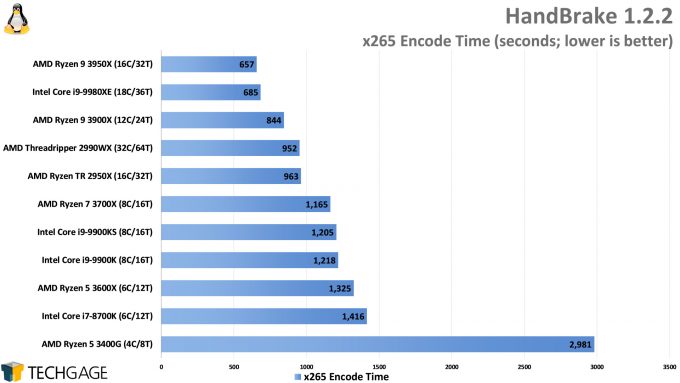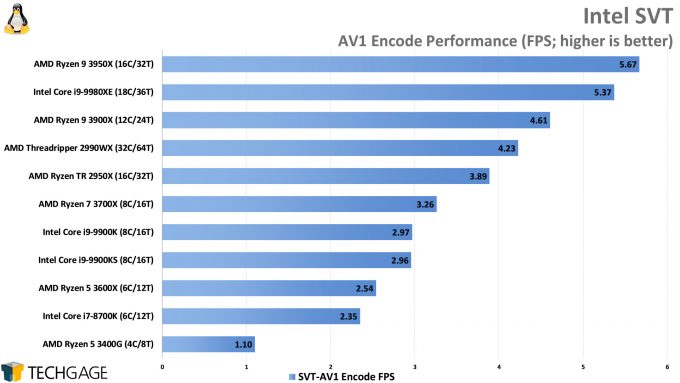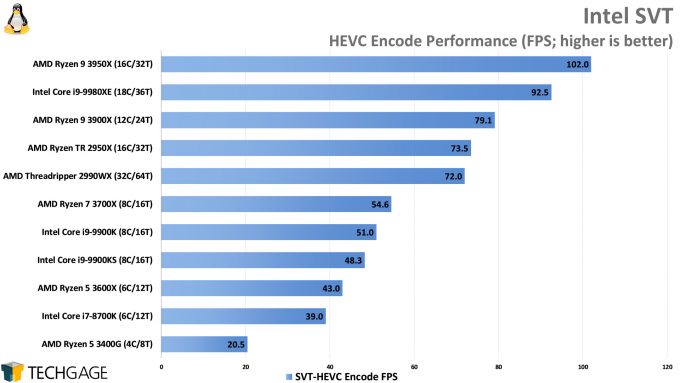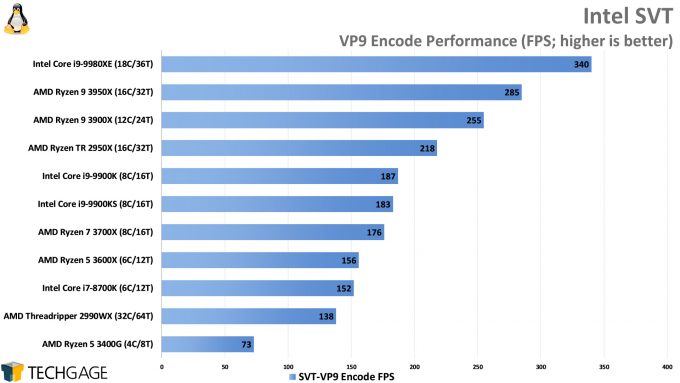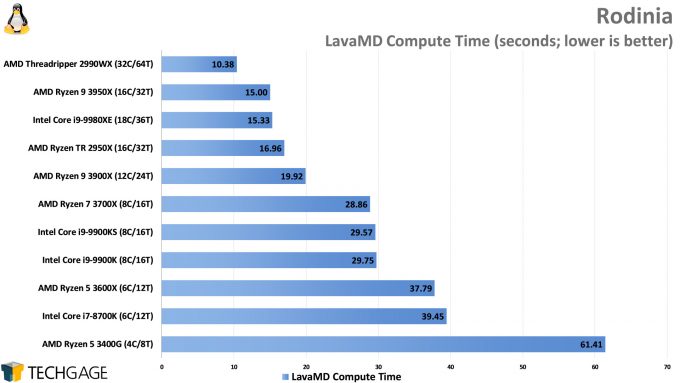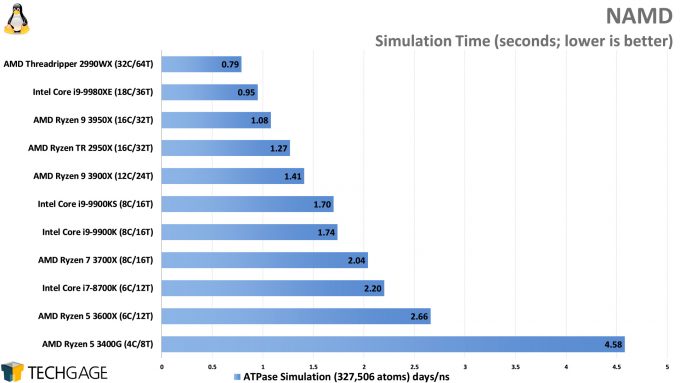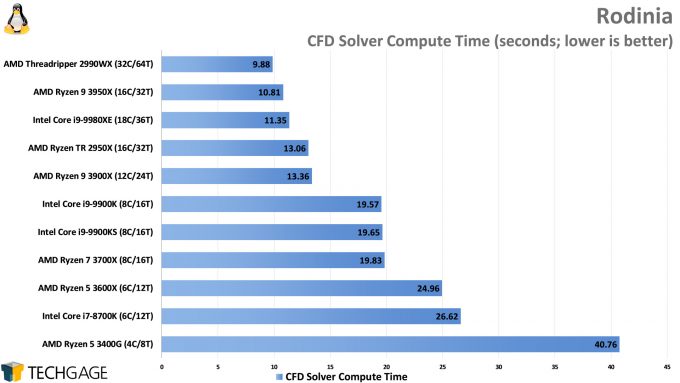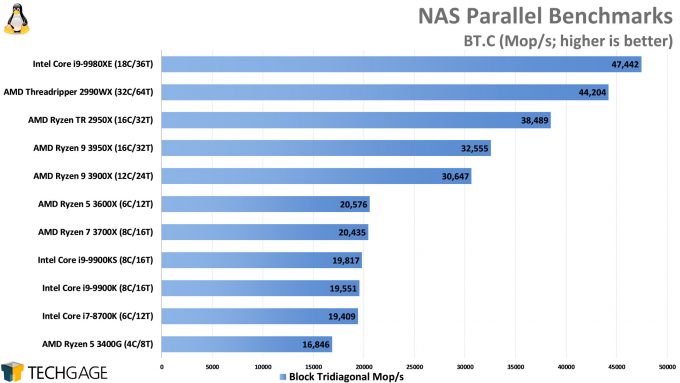- Qualcomm Launches Snapdragon 4 Gen 2 Mobile Platform
- AMD Launches Ryzen PRO 7000 Series Mobile & Desktop Platform
- Intel Launches Sleek Single-Slot Arc Pro A60 Workstation Graphics Card
- NVIDIA Announces Latest Ada Lovelace Additions: GeForce RTX 4060 Ti & RTX 4060
- Maxon Redshift With AMD Radeon GPU Rendering Support Now Available
A Linux Performance Look At AMD’s 16-core Ryzen 9 3950X

With so many CPUs hitting the market this month, it was time to both retest our collection of chips and update our tests. In this article, we’re going to be covering a bunch of workloads in Linux, ranging from compiling to rendering, compute to encryption. AMD’s new 16-core Ryzen 9 3950X joins ten other processors, so let’s see how it stacks up.
Page 2 – Video Encoding & Scientific Performance
We’re going to be tackling both video encoding and scientific performance on this page, and while that sounds like only two things, the reality is that there are a countless number of workloads available in each one, and loads of opportunity to see interesting scaling.
We unfortunately forgot about Blackmagic’s RAW Speed Test having a Linux build, so we’ll make sure that’s included next time. What’s new here video-wise is Intel’s SVT encoder libraries, all of which are open-source. For the latter half of the page, we’ll look at some scientific scenarios.
Video Encoding Performance
One of the most glaring things the above charts make clear is that you really don’t want a really low-end processor for video encoding. The quad-core 3400G is a great CPU for its price, but it’s definitely not made for anyone with heavier computing needs. In this particular test, it actually performs far slower than we’d expect it to. We’re dying to see what Zen 2-infused APUs will look like.
Older versions of HandBrake struggle with many-core processors, so the latest is definitely recommended for the most accurate look at performance scaling. We remember a version last year really struggling on the top-end Threadrippers, but there is no such anomaly nowadays. Cores are clearly not everything here, since the 2990WX can’t overtake the rest of the pack, but that chip in particular performs better than we’d expect given some of its issues (which we’ve covered before).
Intel’s SVT (Scalable Video Technology) is unsurprisingly designed around the company’s own hardware; in this particular case, Xeon Scalable. Given the results we’re seeing, we’d have to say that the encoders seem pretty neutral, despite the Intel name being attached to them. For some proof of that, take a look at the eight-core 3700X beating out the 9900K and 9900KS in AV1 and HEVC. It’s worth pointing out that the 9900KS was slower than the 9900K in all three of these tests for some reason (and repeatable), and we can’t figure out the reason for it (perhaps temperature throttling of some kind?).
With VP9, Intel’s processors have some obvious strengths, allowing the 18-core 9980XE to enjoy fresh air at the top. The 2990WX struggles with that particular test, interestingly enough, a trait we’re sure will carry over to the 2970WX, once we get that tested. On current-gen Zen processors, though, the scaling is fantastic. The 3950X performs great all-around.
Scientific Performance
Both Rodinia’s LavaMD and NAMD are molecular dynamics tests, and both absolutely love cores. The NAMD results scale really well, creating a satisfying set of stairs, albeit with an exaggerated bottom step thanks to the modest quad-core. How the 3950X places in both of these charts is impressive, because it’s effectively matching the 9980XE, but the 2990WX is really showing how cores can be put to good use. That chip’s advantage in LavaMD is massive.
With Rodinia’s fluid dynamics test, we’re seeing similar scaling as in the LavaMD test. The science might have changed, but the scaling works in the favor of the 2990WX here, with the 3950X not falling far behind (unless we’re talking price tags, because the 3950X is proving to be great value.)
We’re not sure what to truly make of NAS Parallel benchmarks, because while they represent the scalability of real workloads, they are very much deliberately made benchmarks, so they should act as a thorough stress of the hardware. Intel’s 18-core and AMD’s 32-core topping this chart isn’t really interesting; what is interesting is the fact that chips with only 2-channel memory are definitely held back. We can see that by the last-gen 16-core Threadripper placing a good distance ahead of the new 3950X.
A chart like this bodes well for the third-gen Threadripper to really impress.
Support our efforts! With ad revenue at an all-time low for written websites, we're relying more than ever on reader support to help us continue putting so much effort into this type of content. You can support us by becoming a Patron, or by using our Amazon shopping affiliate links listed through our articles. Thanks for your support!




